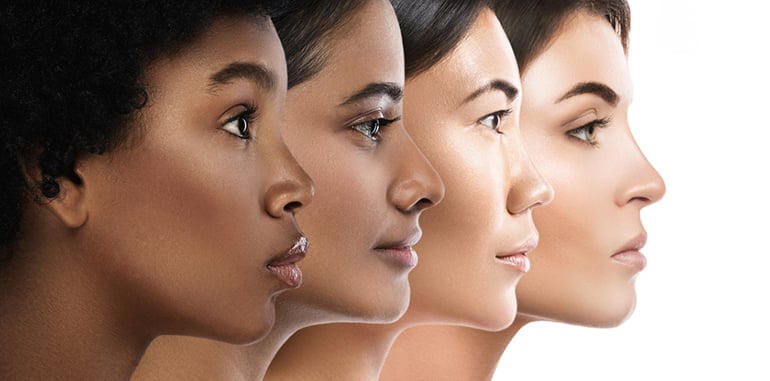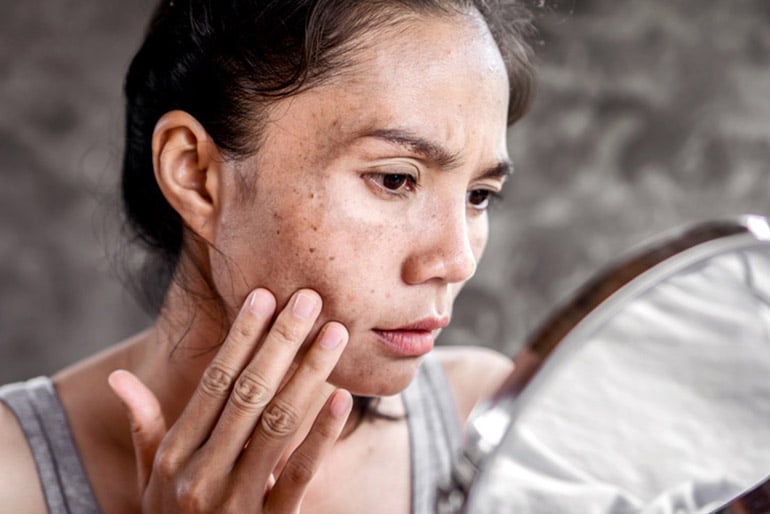Everyone knows that ivory-white, porcelain skin is extremely vulnerable to the effects of the sun. And we feel for those folks who can’t go out and enjoy the day without extensive preparation or fear of burning. But the physical advantage lighter skin has is a plethora of warning signs. It’s a bit easier to tune in to when it’s getting to be too much and when it’s time to cover back up. And they also already know that sunscreen is a must, and often build sun protection into their daily vacation care.
However, those of us with more pigmented skin, be it tan or gold or Brown or Black, are extra susceptible to damage over time. And it’s not a race thing – Caucasians who pick up a tan more easily are also at risk, because what all of these skin tones have in common is that they often feel a false sense of security under a summer sun since they’re less prone to immediate scalding.
But Dr. Simran Sethi, CEO and founder of skin by Dr. Simran Sethi warns us that sun damage to skin can occur without any telltale burning, particularly for people of color. As a woman of color herself, this is a topic that’s particularly close to the doctor’s heart, which inspired her to develop a skincare line specifically for her demographic in order to protect from the harmful impacts of neglecting preventative skincare in the summer and in tropical, beachy destinations like that which ALG Vacations® specializes in. And because vacationers come in all shades, we were delighted to speak to Dr. Sethi for our Ask a Pro series (part of our Plan with a Pro initiative) for not just for a medical perspective on skin protection but also an inclusive perspective on how to be kind to your skin.
Here are some of the “burning” questions she was able to answer for us.
Why do some people tan while others just go right to burnt?
“It is difficult to get a sunburn in skin types that have more melanin,” Sethi tells us. This natural pigment that occurs in hair, skin, and eyes is designed to “absorb and shields the body from the harmful effects of UV radiation,” she explains. A tan is the result of boosted melanin production, the body’s natural response to UV exposure. On the other hand, lighter “skin types 1 – 3 (out of 6) have a greater amount of pheomelanin, which unfortunately, does not have the ability to shield the body from such exposure.”
How can you tell if a tan is actually a burn?
According to the doctor, it’s not about color; it comes down to the peel. “A tan does not cause redness but just more pigmentation of the skin without any peeling, but a sun burn generally causes excessive redness on the skin, followed by peeling and sensitivity the next day.” While darker skin is less likely to burn, if you start to peel, there’s no lack of certainty that you’ve OD’d on vitamin D.
What is the SPF level you most recommend for those who don’t have fair skin?
“All skin types should use an SPF of 30 or higher,” Dr. Sethi emphasizes. “SPFs lower than that have not shown to provide enough protection from UV damage.” Many moisturizers and foundations now include SPF protection, but it’s often defaulted to 15. However, she tells us, “My Skin Protect tinted sunscreen has broad spectrum SPF 40 and I consider it perfect for any summer vacay!” Boosted with botanicals designed for radiance, skin tone improvement, and free-radical protection, it does quad duty in travel-friendly 1.7 ounce bottles.
What’s the best way to use sunscreen?
“Apply sunscreen liberally and evenly 15 minutes before sun exposure, then reapply every two to three hours by gently patting”—not rubbing!—“it onto your face with clean hands,” she advises. The reason you want to have it in place and well absorbed even before you head out is because, according to the American Academy of Dermatology Association, “it takes approximately 15 minutes for your skin to absorb it. If you wait until you are in the sun to apply sunscreen, your skin is unprotected” for that duration of time, which only adds to incremental damage that can lead to issues like hyperpigmentation.
What does hyperpigmentation look like for people of color?
“Hyperpigmentation looks like darkening of the skin tone overall, but can also look like patchy areas of increased darkening of the skin,” she says. This is different from tanning in that the darkening is permanent and in spots rather than uniform across the area and temporary. “If someone has patches of rashes like eczema, or conditions like melasma (which is significantly more common in skin types 4 and 5), they will have increased skin darkening in those areas of their skin.” This is very often caused by sun damage, but can also be a result of hormonal changes and skin inflammation.
Why should hyperpigmentation be avoided?
There’s a big market for dark spot correctors as even, clear skin is still highly regarded, pointing to a cosmetic reason as to why people might want to avoid hyperpigmentation. But there are medical reasons, too. Dr. Sethi says, “Hyperpigmentation is a sign of skin damage. If there is increased pigmentation somewhere, it is a sign that there has been some form of a skin insult like skin barrier breakage caused by acne, rashes, or aggressive products/exfoliants and/or excess exposure to UV light that breaks down collagen.
“In people of color, their melanin is a line of defense against breaking down collagen, so any kind of skin insult will trigger the body to create more melanin.” The body may create it concentration in specific areas based on cellular response, which is why spots emerge as opposed to uniform, blanket color shifts.
So wear your sunscreen, no matter what shade of human you are.
Whether you surface burn or not, your skin will thank you for it!
We all know how important it is to Plan with a Pro when it comes to travel. After all, Travel Advisors Get You There. But equally important is making sure advisor pros are supported and surrounded by pros themselves, particularly when it comes to topics peripheral to travel. That’s where TravelBlogue comes in as we Ask a Pro on your behalf to provide you with tips and advice from fitness, health, nutrition, mental health, beauty, wellness, and travel gear experts from around the world … and put it all at advisor fingertips.







